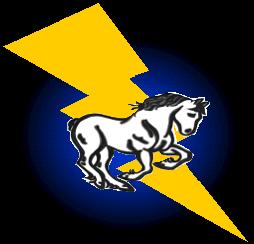  You've Been Thunderstruck! Triple M Farms |  We are the Thunderstruck Percherons from Versailles, Ohio. Our draft horses are black, each weighing over a ton and ranging in height from 17-2 hands to 19-1 hands tall. The Thunderstruck Percherons invite you to let us do your advertising on our hitch wagon at parades or special events. Our horses arrive in parade dress, including a bio-leather harness trimmed in chrome, with tails and manes decorated in the color of your choice. Thunderstruck wagon drivers are also dressed in proper attire. When providing a 6 or 8 horse hitch, the wagon will be accompanied by walkers for the safety of your guests and our horses. You may recognize the Thunderstruck Percherons from such events as: The Great Circus Parade Milwaukee, Wisconsin Baraboo, Wisconsin Indianapolis 500 Parade Indianapolis, Indiana Troy Strawberry Festival Troy, Ohio Annie Oakley Days Parade Greenville, Ohio Little Brown Jug Delaware, Ohio Celina Lake Festival Celina, Ohio Children's Parade Dayton, Ohio Daniel Boone Days Barbourville, Kentucky Easton Mall Lighted Christmas Parade Columbus, Ohio Cincinnati Reds Opening Day Parade Cincinnati, Ohio Circus Festival Parade Peru, Indiana Oktoberfest Parade Minster, Ohio Holiday In Lights Parade Gahanna, Ohio Downtown Lighted Holiday Parade Greenville, Ohio  The Percheron is one of the most famous draft horses from the Perche region of France. The Percheron is used for agricultural work, makes an attractive parade horse, and is a most animated and powerful show horse in heavy harness. Like many old breeds, the Percheron's exact origins are unknown, but it is said that its ancestors were crossbred between the heavy "forest horse" type of animal native to northern Europe and the Arabians that were brought to Europe by the Moors. Percherons probably owe their size and weight to their use as battle mounts during the Middle Ages. After the invention of gunpowder, heavy warhorses were no longer needed, so the Percheron took up its new job pulling heavy French stagecoaches. With the invention of the railroad, Percherons switched to farm duty and heavy labor. It is probably because of this evolution that the modern Percheron is such a versatile and adaptable horse. Today, Percherons serve as logging horses but also are valued as pleasure driving horses, riding horses, and as competitors in both regular horse shows and in draft horse showing. Percherons are noted for heavy muscling and for an aspect of ruggedness and power. Also characteristic of the Percheron is clean action and quality conformation of the feet and legs. The mane is thick, though the tail is usually cut short. The breed is close coupled, wide and deep through the chest, with plenty of back rib. The muscles of the forearms, croup and gaskins are especially emphasized in a good drafter, and ease and balance of gait is essential. The horse is also expected to be of good temperament and be an easy keeper. The Percheron head and neck is typical of the correct draft horse. Good Percherons have a large and full prominent eye, a broad and full forehead, and straight face. A wide jaw and refined ears attractively set and carried with animation are visible evidence of the Percheron's Arabian ancestry. Stallions should have a ruggedness about the head and mares should have a feminine look. The neck is well-shaped and powerful. Percherons have withers well defined, a short back, a deep girth, long, somewhat level croup, big, well-rounded hip, and powerful muscling in the lower thigh. In recent years, modern show Percherons have been bred for a longer, thinner neck, a longer back, and longer, smoother-looking muscles. These types of modern percherons are used mainly as show horses for competition. The Percheron has a very pleasing disposition, and is proud, alert, and intelligent. They are generally very gentle horses, well-suited for driving, and are strong and willing workers. The Percheron is readily adapted to varying climates and conditions. They have the strength to pull heavy loads and the graceful style to pull a fine carriage. Percherons can be ridden and some have even been trained to jump. Percherons are generally black or gray. Some registries only accept those two colors, though chestnut, sorrel, and bay colors are acceptable for registration in the US with a DNA test confirming their parentage. Gray and black are produced by dominant genes. The red gene for chestnut is recessive, and a red foal can only result from the mating of two black horses if they are heterozygous, having the red gene present in both sire and dam, and even then it is only a one in four chance that a chestnut will be produced. Some Percherons have white markings on the head and feet, but excessive white is undesirable. Percherons range in height from 15 to 19 hands high, most are between 16-2 and 17-3 hands high. They can weigh up to 2,600 pounds with the average around 1,900. One of the tallest horses on record was a Percheron named Dr Le Gear. Foaled in 1902, he stood 23 hands (7 feet) at the withers and weighed just under 3,020 pounds. However, there was once a Percheron on record that rose to a full 24 hands. Percherons can be long-lived horses, living over 25 years. An unverified record states a Percheron lived to be 41. |
